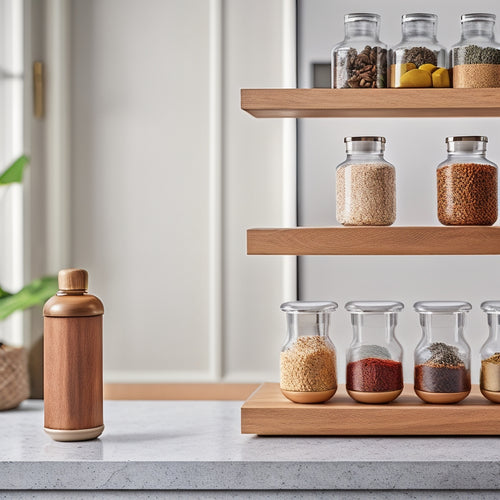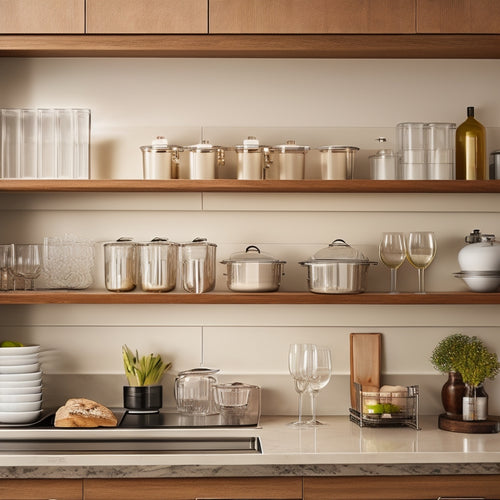
Why Restaurants Need a Digital Kitchen Inventory System
Share
You're likely losing money and wasting valuable resources due to inefficient kitchen inventory management. A digital kitchen inventory system is essential to your restaurant's operational success. By automating inventory tracking, you'll reduce human error, guarantee data accuracy, and integrate technology for streamlined processes. You'll access real-time data to make informed decisions, identify areas of waste, and optimize workflow for reduced waste and increased profitability. With a digital system, you'll receive automated stock alerts, reduce overordering, and strengthen supplier relationships. To learn how to transform your kitchen operations and boost your bottom line, explore how a digital kitchen inventory system can help you achieve accuracy, efficiency, and growth.
Key Takeaways
• A digital kitchen inventory system reduces human error, ensuring data accuracy and streamlining processes for informed decisions.
• It helps identify areas of waste, enabling cost reduction and optimized menu engineering for increased profitability.
• Digital inventory tracking provides real-time data, allowing restaurants to make data-driven ordering decisions and minimize stockouts.
• Automated stock alerts and inventory rotation features reduce waste, prevent over-ordering, and maintain precise inventory levels.
• A digital kitchen inventory system boosts the bottom line by streamlining operations, reducing waste, and optimizing menu pricing and promotions.
Eliminating Human Error in Inventory
By automating inventory tracking, you can reduce the likelihood of human error, freeing up staff to focus on more critical tasks and improving overall restaurant efficiency.
With inventory automation, you can guarantee data accuracy, eliminating the possibility of manual mistakes that can lead to stockouts, overstocking, or wasted resources. By integrating technology into your inventory management, you can streamline processes, reducing the time spent on manual counting and reconciliations.
Moreover, inventory automation provides real-time data, enabling you to make informed decisions about ordering, pricing, and menu planning. This accuracy also helps you identify areas of waste, allowing you to optimize your inventory and reduce costs.
Streamlining Kitchen Operations Efficiency
With accurate inventory data at your fingertips, you can now focus on streamlining kitchen operations to maximize efficiency and productivity. By implementing a digital kitchen inventory system, you can optimize your workflow, reducing waste and increasing profitability.
Start by analyzing your current inventory organization and identifying areas for improvement. This might involve reorganizing your storage spaces, labeling ingredients, and establishing a first-in, first-out system.
Next, develop a training plan to guarantee that all staff members understand the new system and their roles within it. This could include workshops, on-the-job training, and ongoing support.
When implementing the system, consider phasing it in gradually, starting with a small pilot program and gradually scaling up. This will help you identify and address any issues before they become major problems.
Reducing Food Waste and Overstocking
When you implement a digital kitchen inventory system, you'll be able to accurately track your ingredients and optimize your stock levels. This means you'll know exactly how much of each item you have on hand, and you'll be able to order just what you need, reducing the risk of overstocking and waste.
Accurate Ingredient Tracking
You can greatly reduce food waste and overstocking by implementing an accurate ingredient tracking system that accounts for every item in your kitchen. This system helps you keep tabs on ingredient expiration dates, ensuring that you use the oldest items first and avoid expired ingredients that can compromise food safety.
With accurate tracking, you'll know exactly what you have in stock, reducing the likelihood of overordering and minimizing waste. Inventory organization is also simplified, as you can easily categorize and locate specific ingredients. This precision also enables you to identify slow-moving items, allowing you to adjust your inventory accordingly.
By maintaining a precise inventory, you'll be able to create more accurate orders, reducing the risk of overstocking and waste. Additionally, you'll have a better understanding of your kitchen's usage patterns, enabling you to make informed decisions about inventory management and menu planning.
Optimized Stock Levels
By maintaining optimized stock levels, restaurants can strike a delicate balance between having enough ingredients on hand to meet demand and avoiding excess inventory that can lead to waste and unnecessary expenses.
You can guarantee that your kitchen is always stocked with the right amount of ingredients, reducing the risk of overstocking and waste.
Here are some ways a digital kitchen inventory system can help you achieve optimized stock levels:
-
Automated stock alerts: Receive notifications when stock levels are running low, so you can reorder ingredients before they run out.
-
Stock rotation: Guarantee that older ingredients are used before they expire, reducing waste and improving inventory turnover.
-
Inventory tracking: Get real-time updates on your inventory levels, so you can identify slow-moving items and adjust your orders accordingly.
- Data-driven ordering: Use historical sales data and inventory trends to inform your ordering decisions, ensuring you're stocking up on the right ingredients in the right quantities.
Improving Supply Chain Visibility
About 60% of restaurant owners report that they struggle with inventory management, which is largely due to a lack of visibility into their supply chain operations.
As a restaurant owner, you know how essential it's to have a clear view of your supply chain to make informed decisions. A digital kitchen inventory system can help you achieve this by providing real-time inventory transparency.
With this system, you can track your inventory levels, monitor stock movements, and identify areas for improvement. This increased visibility enables you to strengthen your supplier relationships by making data-driven decisions and optimizing your ordering process.
Enhancing Recipe Management and Costing
When you implement a digital kitchen inventory system, you'll be able to scale recipes with precision, ensuring you're using the right amount of ingredients and minimizing waste.
You'll also be able to track the cost of each ingredient in real-time, giving you a clear picture of your menu's profitability.
With the ability to make updates to recipes in real-time, you can easily adjust to changes in ingredient availability or pricing, keeping your kitchen running smoothly and efficiently.
Accurate Recipe Scaling
You need precise recipe scaling to guarantee consistency in your dishes and accurate cost control, as even small variations in ingredient quantities can greatly impact your restaurant's bottom line. This is especially important when you're preparing large quantities of food, as small mistakes can add up quickly.
With a digital kitchen inventory system, you can make sure that your recipes are scaled accurately, every time.
Here are just a few benefits of accurate recipe scaling:
-
Portion control: Make sure that every dish that goes out is consistent in terms of portion size, reducing waste and improving customer satisfaction.
-
Ingredient consistency: Ensure that every ingredient is used in the correct proportion, ensuring that your dishes taste the same every time.
-
Waste reduction: Minimize waste by avoiding over-preparation of ingredients, reducing your environmental impact and saving you money.
- Cost efficiency: Optimize your inventory and reduce costs by making sure that you're only ordering what you need, when you need it.
Ingredient Cost Tracking
By tracking the cost of each ingredient, your restaurant can refine its recipe management and costing, ensuring that every dish is priced accurately and profitably. This level of precision allows you to negotiate better deals with vendors, as you'll have a clear understanding of your ingredient costs.
With accurate cost tracking, you can identify areas where you can optimize your menu pricing to maximize profits. For instance, if you notice that a particular ingredient is driving up the cost of a dish, you can adjust the recipe or portion size to maintain profitability.
Moreover, having a digital kitchen inventory system that tracks ingredient costs enables you to make data-driven decisions when it comes to menu engineering. You can analyze the cost of each dish and identify opportunities to increase profitability without compromising on quality. By doing so, you can create a menu that's both appealing to customers and profitable for your restaurant.
With accurate ingredient cost tracking, you'll be able to strike the perfect balance between pricing and profitability, ultimately leading to increased revenue and a more sustainable business model.
Real-Time Recipe Updates
With real-time recipe updates, your restaurant can instantly reflect changes to ingredient quantities, pricing, or supplier information, ensuring that your recipe management and costing remain accurate and up-to-date.
This means you can:
-
Easily manage ingredient substitutions, ensuring that your dishes remain consistent and safe for customers with food allergies or dietary restrictions.
-
Monitor inventory levels and adjust recipes accordingly, reducing waste and saving you money.
-
Customize menus to suit changing customer preferences and seasonal ingredient availability, while maintaining accurate cost analysis.
- Instantly update recipe costing to reflect changes in ingredient prices or supplier information, ensuring that your profit margins remain healthy.
Maximizing Profitability and Growth
Implementing a digital kitchen inventory system can greatly boost a restaurant's bottom line by streamlining operations, reducing waste, and optimizing menu engineering.
You'll be able to achieve inventory accuracy, which has a direct financial impact on your business. With accurate inventory levels, you can identify areas of waste, reduce over-ordering, and minimize stockouts.
This, in turn, will help you make informed decisions about menu engineering, pricing, and promotions.
Frequently Asked Questions
Is a Digital Kitchen Inventory System Suitable for Small Restaurants?
Think of your inventory like a puzzle; a digital system helps you find the missing pieces. You'll find a digital kitchen inventory system suitable for your small restaurant, as it's cost-effective, scalable, and boosts operational efficiency and inventory accuracy.
Can a Digital System Integrate With Existing Point-Of-Sale Software?
You'll find that most digital kitchen inventory systems can integrate seamlessly with your existing point-of-sale software, ensuring system compatibility and cost-effective implementation, giving you a streamlined and safe operational process.
How Much Training Is Required for Kitchen Staff to Use the System?
You'll be relieved to know that 80% of restaurants see a significant reduction in inventory errors within the first month of implementing a digital system. With minimal training requirements, you'll overcome implementation challenges and get your kitchen staff up to speed in no time.
Are Digital Kitchen Inventory Systems Secure and Protected From Data Breaches?
You want to know if digital kitchen inventory systems are secure? Yes, they are! They implement robust cybersecurity measures and data encryption to protect your sensitive info, giving you peace of mind and ensuring your data remains safe.
Can a Digital System Be Customized to Accommodate Unique Menu Items?
You can customize a digital system to fit your unique menu items, allowing you to accurately track inventory, manage ingredients, and analyze costs, ensuring precise menu customization and efficient inventory tracking.
Related Posts
-

Wall-Mounted Dish Drainer Racks for Kitchens
Wall-mounted dish drainer racks are a game changer for your kitchen. They maximize vertical space, freeing up preciou...
-

Modern Countertop Spice Organizer Designs
Modern countertop spice organizer designs enhance your kitchen's aesthetics while maximizing functionality. These spa...
-

Pull-Out Cabinet Shelves for Dish Drainer Storage
Pull-out cabinet shelves are a revolutionary innovation for your dish drainer storage. They maximize vertical space a...


